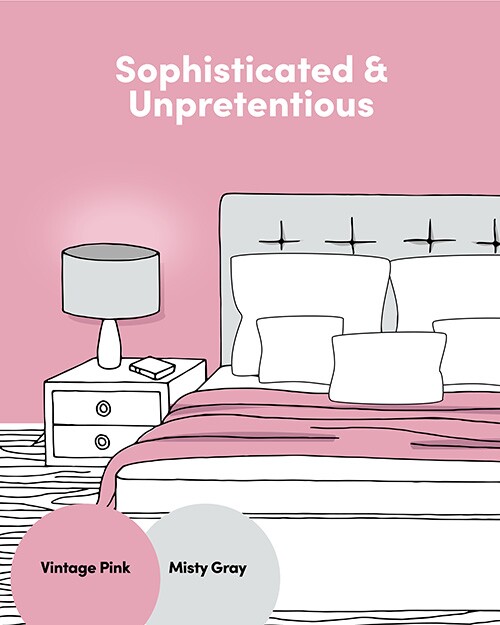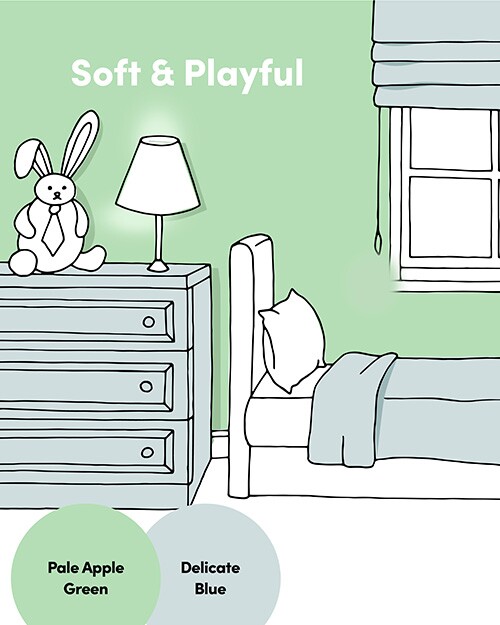We may not need a scientific study to tell us there’s a relationship between mood and color — intuition often handles that. People know what they like, and what makes them feel a certain way, whether calm or fired up.
There's plenty of research to support the impact of color on a mood. For example, did you know the combination of red and yellow can help increase one’s appetite and stimulate metabolism? Plenty of fast food marketers sure do.
But aside from the science behind it, color interpretation can be a deeply personal experience. If you had a red and yellow bedroom as a child, you probably weren’t rushing to chew on the wallpaper. What may induce a particular emotion for one person may summon something entirely different for another. And what may feel or look good to that person could be entirely off-trend unsettling in a shared living space (especially for harsh, bright, vivid colors).
When it comes to the bedroom, we typically prefer a calmness and tranquility that will lull us to sleep each night. But given how personal and intimate the space is, we also want to get creative and include the colors that resonate with us most.
To help us find the right balance for our sleep sanctuaries, we sought the bedroom color advice of two experts: Amy Wax, a world-renowned color specialist and former president of the International Association of Color Consultants of North America, who has dedicated her life to using “color to improve and benefit the lives of others,” as well as self-proclaimed “color-obsessed” NYC designer Anthony Gianacakos of Anthony George Home to offer helpful decorating tips on how best to incorporate these specific colors into paint, furniture, and accessories.
Color theory and sleep: How to pick a color for your bedroom
Before delving into the recommendations, Wax and Gianacakos were quick to remind us that, again, the perception of color is ultimately unique to the individual.
“How we see and interpret colors is a very personal experience,” says Wax. “It is also important to remember that each of us sees color in our own unique way, largely inspired by our own life experiences. As a viewer, you might feel drawn to softer, airier colors, as they give you a sense of peacefulness inside. On the contrary, bolder colors will cause a stronger physical reaction, and saturated colors could cause eye strain and might energize you or even raise your blood pressure.”
“Each of these processes starts with the eyes’ perception and how the brain converts that into the personal emotional responses to the colors we are seeing,” she adds.
Gianacakos echoes this sentiment, underscoring that bedroom color selection is ultimately at the discretion of his clients.
“There are no rules,” he claims. “Just go with what makes you happiest.”
The concept of color theory and our psychological response to different shades is, however, heavily researched and there are certain hues that are more likely than others to exude the peacefulness we desire as our heads hit the pillow. Experts like Wax and interior designers like Gianacokes have honed in on the most common, while also taking a client’s lifestyle and personal design aesthetic into consideration.
The best colors to paint your bedroom
Despite the personal experience of color selection, there are 20 shades of colors (and color combinations) that have been proven (sometimes scientifically) to evoke certain emotions amongst most people.

Again, there are no hard and fast rules when it comes to decorating, but keep these colors in mind if you’re looking for design ideas that’ll transform your bedroom into the sleep sanctuary of your dreams. (Wax has provided the colors and emotions, and Gianacakos speaks to the design tips.)
Delicate blue
Hex code: #D0DDDE
Mood: “Soft, airy, and heavenly.”
Design tip: “Because this color will likely remind you of a beautiful sky, try painting your ceiling light blue to imitate the calm feeling you have when lying down in a park.”
Complementary colors: Salmon, aqua, and marigold.
Who would love this: Those who seek comfort from the great outdoors may find solace in the powder blues that remind them of the sea or sky. Naturally, it should be most appealing to air and water signs.
Lavender
Hex code: #D7CCDB
Mood: “Starry-eyed and romantic.”
Design tip: “Lavender is a gorgeous color, but it can overwhelm a living area. Stick to using it as accents, like drapes against a darker wall.”
Complementary colors: White, mint, and khaki.
Who would love this: If the spa is your respite and the smells of actual lavender bring you joy, what better way to mirror this safe haven than with the color itself? It could even help bring balance to those with over-anxious personalities.
Pale gray
Hex code: #D5D8D1
Mood: “Open-minded and easy-going.”
Design tip: “This is the most versatile wall color for a bedroom. It keeps the foundation clean and neutral and allows you to go either warm or cool with the secondary accents and colors, but choose one and keep it consistent. Feel free to paint the entire room with this shade, but don’t leave it too empty or it can feel cold and depressing.”
Complementary Colors: Anything but itself.
Who would love this: Those who struggle with indecisiveness will benefit from this neutral shade that shows you’ve at least put in some effort beyond stark-white walls.
Blue-green
Hex code: #ADCCCA
Mood: “Truly tranquil.”
Design tip: “This color is commonly used in hotels at tropical resort destinations, which should conjure the same emotions of relaxation and provide more of a ‘destination’ vibe when you walk in. Use it boldly and loudly, but only in one area, like an oversized rug, comforter, or wall color.”
Complementary colors: Dark brown, royal blue, and gold.
Who would love this: If the beach calls you and you’re always dreaming about your next vacation, give blue-green a shot. It’s also a great choice for those who are inspired by creativity and don’t necessarily like the idea of turning their brain *completely* off at night.
Pale apple green
Hex code: #B6DEB6
Mood: “Refreshing and uplifting.”
Design tip: “This would actually be a great bedroom color for a nursery. It is gender-neutral and soft enough to pair well with wonderful wood furniture."
Complementary colors: Turquoise, light brown, and light gray.
Who would love this: Anyone who enjoys retro vibes. If you’re a bit old-fashioned and collect antique furniture, this could be the perfect backdrop.
Dreamy pink
Hex code: #EBCDC3
Mood: “Romantic and tender.”
Design tip: “The key to using feminine colors is layering. To avoid making the space look like a princess room, be sure to contrast it with bold colors like orange, yellow, or blue to bring in a level of sophistication. From there, layer on neutral softs like creams, whites, taupes, and grays to serve as the foundation to your louder fabrics, which will also bring in the aforementioned romance.”
Complementary colors: Orange, yellow, blue, and neutrals.
Who would love this: This is for the carefree individual who has embraced femininity and also has fun with design (since it will require some bold design decisions to support it).
Vintage pink
Hex code: #E6A5B7
Mood: “Quaint and charming.”
Design tip: “This color runs the risk of looking either trendy or dated. Definitely opt for using it in a headboard or drapery so that it can easily be swapped out if it begins to look tacky.”
Complementary colors: Pale gray, black, and white.
Who would love this: Like the pale apple green, this shade is for someone who values the colors and designs of the past. But if you pair it with gray, black, and white, you can create a romantic, timeless space that’s perfect for anyone who may have idolized Cher from Clueless.
Breezy blue
Hex code: #E1EEF7
Mood: “Care-free and airy.”
Design tip: “Use this color to paint a ceiling. It will obviously resemble the sky and the darker the blue, the more it will take on the cloud color of a thunderstorm. Searching for the mood of the ocean instead? Opt for a rug!”
Complementary colors: Navy, creams, and white.
Who would love this: Breezy blue lends itself well to nautical décor, so if you’re a water sign or have always dreamed of living on the ocean, this is the shade that will keep those dreams alive.
Warm gray
Hex code: #DED8D2
Mood: “Earthy and warm.”
Design tip: “You can’t go wrong, especially if you are scared to use color on a wall. Remember that wall color sometimes demands versatility — you want something that can be used for years to come and still work with any type of furniture. This is that shade, but its darker shade brings in an earthiness that can feel quite comforting.”
Complementary colors: Anything but itself.
Who would love this: Nature-seekers will appreciate the warmth that this gray brings, especially because it pairs fabulously with dark, natural woods and lots of houseplants.
Light cream
Hex code: #FBF3E6
Mood: “Velvety and luxurious.”
Design tip: “I would use this light cream on the trim, molding, and doors and go for a bolder color on the wall. Faux fur throws, drapes, and anything with lots of texture would also look lovely in light cream.”
Complementary colors: Practically anything.
Who would love this: If you appreciate the finer things in life (or like faking it until you make it), a light cream can make anything look expensive. And what makes you sleep more soundly than financial security?
Light coral
Hex code: #F7CFBB
Mood: “Comforting and compassionate.”
Design tip: “This color would look great in a guest room. It will make your guest feel special by creating a mood that will likely not match the rest of the house. Try painting an accent wall with it and have fun with bedspread patterns and even matching wallpaper.”
Complementary colors: Turquoise, creams, and white.
Who would love this: Your guests. It’s not ideal for an everyday situation, but its playfulness can be charming and comforting for a few nights if it dominates an entire room.
Blue-gray
Hex code: #A5B6C4
Mood: “Smoky and elegant.”
Design tip: “If you want your bedroom to feel somewhat moody and almost cocoon-like, this is your color. It creates wonderful drama while remaining understated and refined. Avoid making the room too dark by just painting the wall behind your bed or even framing the headboard with it and using something lighter on either side.”
Complementary colors: Goldenrod, light teal, and light blue.
Who would love this: If you haven’t checked out your chronotype, breezy blue is wonderful for owls whose energy peaks at night. They don’t mind being surrounded by a darker atmosphere. In fact, they embrace it.
Light teal
Hex code: #92CED4
Mood: “Serene and lighthearted.”
Design tip: “You’d really be making a statement with this one if it covered your walls. Your teenager will probably enjoy this shade, but adults may want to use it sparingly in their own room. Vases, lamps, and knick-knacks should suffice.”
Complementary colors: Cream, orange, and yellow.
Who would love this: Anyone who doesn’t take themselves too seriously and continues to embrace the joy and carefreeness of their youth.
Pale violet
Hex code: #d4d4dd
Mood: “Dreamy and romantic.”
Design tip: “It brings less depth and richness than lavender, making it an ideal wall color that will contrast nicely against darker furniture.”
Who would love this: This color will lend itself beautifully to any bedroom. It can play as a neutral or be the baseline of a more sumptuous space fit for a queen or king. If you’re a person who enjoys excess like tufted headboards, chandeliers, and velvet ottomans, this is the color for you.
Misty gray
Hex code: #DBDFE0
Mood: “Quiet and unassuming.”
Design tip: “Misty gray is a gorgeous color with its cooler tones, but it’s one you must sample [before committing] on a wall. The lighting will completely impact how it appears, making it more green in some homes. But like the pale and warm grays, it can certainly make a great and safe neutral for a 360-degree wall color.”
Complementary colors: Practically anything.
Who would love this: Since this is a brighter gray, chances are likely that it will appeal to a morning person, a lark or hummingbird chronotype who appreciates when actual mist is created, as the world around them rises to start the day.
Beautiful paint color combinations for the bedroom
The aforementioned colors work great on their own, but can be enhanced when paired. Here are five color combinations that Wax has approved, as well as Gianacakos’ design recommendations.
Light cream & lavender

Hex codes: # FBF3E6 (light cream) and #D7CCDB (lavender)
Mood: Charming and romantic.
Design tip: Lots of textural fabrics for drapery, pillows, and upholstery.
Blue-green & warm gray

Hex codes: #ADCCCA (blue-green) and #DED8D2 (warm gray)
Mood: Easy-going and warm; earthy.
Design tip: Add additional layers of bold colors with abstract art in cool tones.
Light teal & light coral

Hex codes: #92CED4 (light teal) and #FBF3E6 (light cream)
Mood: Refreshing and cozy; earthy.
Design tip: Make one color more prominent than the other.
Vintage pink & misty gray

Hex codes: #E6A5B7 (vintage pink) and #DBDFE0 (misty gray)
Mood: Relaxing and serene; sophisticated yet unpretentious; appeals to all genders.
Design tip: Think outside of the box with a mural or splatter-painted drapery panels.
Pale apple green & delicate blue

Hex codes: #B6DEB6 (pale apple green) and #D0DDDE (delicate blue)
Mood: Soft and playful; appeals to all ages.
Design tip: Consult a professional. This color combo is tricky!
Bedroom colors to avoid
- Neon
- Red
- Orange
- Dark browns
While color boils down to personal preference, there are still a few that you probably want to avoid.
“Anything obnoxiously bright or neon,” Gianacakos says. “You don’t really want anything to remind you of the sun as you’re closing your eyes to fall asleep.”
Additionally, red can evoke feelings of anger, orange can inspire energy increases, and dark browns can make a space look smaller and gloomy.
“You’ll have difficulty getting out of the bed in the morning if you go with brown,” Gianacakos adds.
Design tips for color beginners
- Play with textures
- Buy furniture with rounded edges
- Invest in soft lighting
- Incorporate patterns and high-contrast artwork
Whether you’re new to color matching or even unable to see the nuance between hues and, shades — or color altogether — you can still play around with fabrics, lighting, and furniture selection, and design the room to your enjoyment.
“Bring textures into a room that are plush and inviting. Buy furniture with rounded edges so that the room isn’t too modern and sterile-looking,” Giancakos advises. “And always invest in soft lighting so that its brightness is controllable.”
There are also unique patterns, in fabrics like bedding and throws, and high-contrast artwork that are visually appealing to anyone, regardless of the colors they see.
“Creativity isn’t limited to color. There are so many other elements of design that can help you create an inviting, relaxing space where you can put your head down,” he adds.
Whether you opt for one of the aforementioned 20 or find a different color that has you counting sheep and catching Zzz’s, take comfort in knowing that nothing is permanent and that tastes may change or evolve.
“The beauty of color is that it can transform,” reminds Wax. “And when the colors are just right, they can soothe the soul.”






